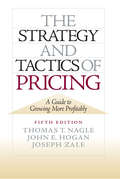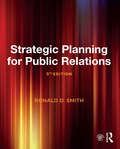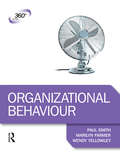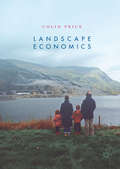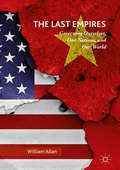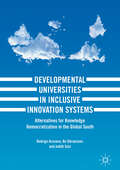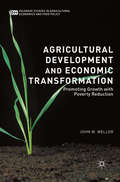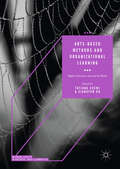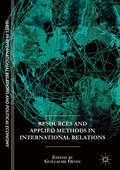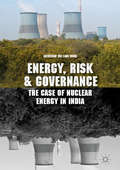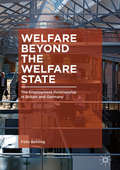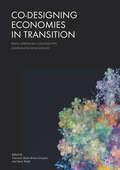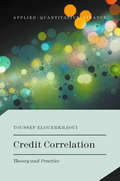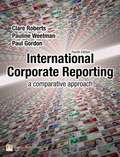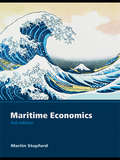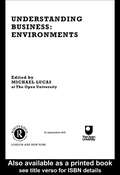- Table View
- List View
The Strategy and Tactics of Pricing: New International Edition
by Thomas T. Nagle John Hogan Joseph ZaleFor undergraduate introduction to Market Pricing courses. A comprehensive and practical, step-by-step guide to pricing analysis and strategy development. The Strategy and Tactics of Pricing shows readers how to manage markets strategically—rather than simply calculate pricing based on product and profit—in order to improve their competitiveness and the profitability of their offers. The fifth edition contains a new chapter on price implementation and several updated examples on pricing challenges in today’s markets. Features: NEW! Show students how proper pricing can increase profitability—New Chapter on Price Implementation. A completely new chapter on implementing pricing strategy identifies the challenges involved in embedding strategic pricing principles within an organization. This chapter also describes how managers can lead a structured change process to build a more profitable commercial organization. NEW! Offer access to pricing software—Three-Month Trial of LeveragePoint Software. This edition is now available with software for creating and communicating economic value estimations systematically—from LeveragePoint Innovations Inc. While versions of this software that enable sharing require corporate contracts for access, versions for individual student and practitioner use are available without charge for three months with the purchase of The Strategy and Tactics of Pricing. NEW! Make pricing theory relative—Updated Examples of Pricing. Helping connect pricing theory to what students are familiar with, this edition includes updated examples with more topical illustrations of current pricing challenges such as: • iPhone pricing • New models for pricing music • Services pricing NEW! Present the latest information—Heavily Revised Chapters. The revised chapter on Pricing Policy provides a theoretically-grounded framework to describe specific policies for managing price changes for situations such as:-Cost-based price increases -Price reductions in a recession-Discounts The chapter on Value Creation now addresses the difference between how to consider value when it is driven by tangible monetary drivers (saving money on gas) versus the more subjective psychological drivers (doing the right thing for the environment). The chapter on Value and Price Communication has been substantially revised to describe how to communicate value in a wide variety of product and customer contexts. This chapter also demonstrates how to target communications to affect specific behaviors throughout the customer’s buying process.The chapter on Price Setting has been expanded to provide a robust process for setting prices that can be widely applied to consumer and business markets.
The Strategy and Tactics of Pricing: New International Edition
by Thomas T. Nagle John Hogan Joseph ZaleFor undergraduate introduction to Market Pricing courses. A comprehensive and practical, step-by-step guide to pricing analysis and strategy development. The Strategy and Tactics of Pricing shows readers how to manage markets strategically—rather than simply calculate pricing based on product and profit—in order to improve their competitiveness and the profitability of their offers. The fifth edition contains a new chapter on price implementation and several updated examples on pricing challenges in today’s markets. Features: NEW! Show students how proper pricing can increase profitability—New Chapter on Price Implementation. A completely new chapter on implementing pricing strategy identifies the challenges involved in embedding strategic pricing principles within an organization. This chapter also describes how managers can lead a structured change process to build a more profitable commercial organization. NEW! Offer access to pricing software—Three-Month Trial of LeveragePoint Software. This edition is now available with software for creating and communicating economic value estimations systematically—from LeveragePoint Innovations Inc. While versions of this software that enable sharing require corporate contracts for access, versions for individual student and practitioner use are available without charge for three months with the purchase of The Strategy and Tactics of Pricing. NEW! Make pricing theory relative—Updated Examples of Pricing. Helping connect pricing theory to what students are familiar with, this edition includes updated examples with more topical illustrations of current pricing challenges such as: • iPhone pricing • New models for pricing music • Services pricing NEW! Present the latest information—Heavily Revised Chapters. The revised chapter on Pricing Policy provides a theoretically-grounded framework to describe specific policies for managing price changes for situations such as:-Cost-based price increases -Price reductions in a recession-Discounts The chapter on Value Creation now addresses the difference between how to consider value when it is driven by tangible monetary drivers (saving money on gas) versus the more subjective psychological drivers (doing the right thing for the environment). The chapter on Value and Price Communication has been substantially revised to describe how to communicate value in a wide variety of product and customer contexts. This chapter also demonstrates how to target communications to affect specific behaviors throughout the customer’s buying process.The chapter on Price Setting has been expanded to provide a robust process for setting prices that can be widely applied to consumer and business markets.
Strategic Planning for Public Relations
by Ronald D. SmithStrategic Planning for Public Relations is in its fifth edition of offering an innovative and clear approach for students looking to learn how to develop public relations campaigns. It is a text intended for those serious about entering the rapidly changing professions of public relations and strategic communication. Ronald Smith shows how to implement pragmatic, research-driven strategic campaigns used in public relations practice, and draws from his years of experience as a professional in the industry and his years of teaching in the classroom. The approach used in this text is a threefold pattern: first, readers are exposed to new ideas, then see them in use, before finally being showed how to apply those ideas themselves. Complex problem-solving and decision-making processes in strategic communication and public relations are turned into a series of easy-to-follow steps, flexible enough to be applicable to myriad situations and organizations in the real world. This new fifth edition follows the same format as previous editions and includes numerous timely and real-world examples of cases and current events, along with classic cases that stand the test of time. It includes new research on opinions and practices within the discipline and covers several recent, award-winning public relations campaigns.
Strategic Planning for Public Relations
by Ronald D. SmithStrategic Planning for Public Relations is in its fifth edition of offering an innovative and clear approach for students looking to learn how to develop public relations campaigns. It is a text intended for those serious about entering the rapidly changing professions of public relations and strategic communication. Ronald Smith shows how to implement pragmatic, research-driven strategic campaigns used in public relations practice, and draws from his years of experience as a professional in the industry and his years of teaching in the classroom. The approach used in this text is a threefold pattern: first, readers are exposed to new ideas, then see them in use, before finally being showed how to apply those ideas themselves. Complex problem-solving and decision-making processes in strategic communication and public relations are turned into a series of easy-to-follow steps, flexible enough to be applicable to myriad situations and organizations in the real world. This new fifth edition follows the same format as previous editions and includes numerous timely and real-world examples of cases and current events, along with classic cases that stand the test of time. It includes new research on opinions and practices within the discipline and covers several recent, award-winning public relations campaigns.
Unlocking the Business Environment
by John Brinkman Ilve Navarro Donna HarperThe business environment is a fundamental subject in any Business Studies degree course. This new, student-friendly book divides the subject into the internal and external environment and, where relevant, discusses the interface between the two. It is written with the outward-looking student in mind and, as a result, encourages readers to reflect on what they have read and to consolidate their learning through regular self-testing exercises and discussion points. The text contains highly relevant and 'household name' case studies, ensuring that it is a highly topical and engaging book. Where organisational styles differ, the authors put forward the pros and cons of different points of view, ensuring that students have the information necessary to make up their own minds and develop management strategies of their own.
Organizational Behaviour
by Paul Smith Marilyn Farmer Wendy YellowleyClear, concise, and written by experts currently lecturing in the field, Organizational Behaviour focuses exclusively on what you need to know for success in your business course and today's global economy. For a focused view of organizational behaviour, this is the book for you. The concise, accessible style makes this the perfect text for introductory courses covering organizations and is well suited to international students. This innovative textbook features: a clear and thought-provoking introduction to organizational behaviourrelevant, cutting-edge case studies with global focus hot topics such as emotional intelligence, corporate responsibility, Generation Y and ethics keep you up-to-date with current business thinking summaries, activities, key theme boxes and review questions to help reinforce your understanding Part of the 360 Degree Business series, which provides accessible yet stimulating introductions to core business studies modules, this textbook comes with additional support materials including further case studies, revision summaries and interactive multiple choice questions available online at www. routledge. com/cw/farmer.
Unlocking the Business Environment
by John Brinkman Ilve Navarro Donna HarperThe business environment is a fundamental subject in any Business Studies degree course. This new, student-friendly book divides the subject into the internal and external environment and, where relevant, discusses the interface between the two. It is written with the outward-looking student in mind and, as a result, encourages readers to reflect on what they have read and to consolidate their learning through regular self-testing exercises and discussion points. The text contains highly relevant and 'household name' case studies, ensuring that it is a highly topical and engaging book. Where organisational styles differ, the authors put forward the pros and cons of different points of view, ensuring that students have the information necessary to make up their own minds and develop management strategies of their own.
Landscape Economics (PDF)
by Colin PriceThis revised and expanded edition of Colin Price's seminal publication provides a richly comprehensive and up-to-date coverage of landscape economics, a subject which has until now been addressed only in limited aspects. Although much of the book's discussion is based upon natural resources and environmental economics, the author presents a wide and integrative view, drawing from aesthetic, psychological, social and political perspectives and applying a critical use of economic concepts and challenges to different schools of thought on the landscape. This new edition includes new ideas and critiques on environmental valuation; more focused critiques of stated preference methods, political alternatives to economic valuation, and of the rationale of discounting future values; and, new evaluative techniques, particularly price premia for products with a landscape provenance.For those interested in the theoretical aspects of aesthetic valuation, and for those who seek solutions to practical problems of aesthetic conservation, amelioration and enhancement, this new edition gives an overview of evaluative techniques, of their potential problems and of possible solutions. The updates are a major contribution to the growing literature in the field.
The Last Empires: Governing Ourselves, Our Nations, and Our World (PDF)
by William AllanThis book is a forthright and novel examination of efforts to improve national and global governance over the last forty years. Much has changed since Michel Foucault considered, and rejected, economics and neoliberalism as a potential mechanism for individuals to govern themselves and their nations. Nonetheless, his approach, which focused on the evolution of social development through interaction of many disciplines and biopolitical forces, remains highly relevant. Neoliberalism became a dominant political force from the 1980s to the present. It has failed however to address issues of inequality, to ensure economic stability, or to tackle the problems of people and nations that have been marginalized by industrial progress and international conflict. Market forces alone cannot meet the needs of global society. Now, however, developments in behavioural theory, institutional theory and analysis, accounting theory and accountability practice are providing tools that are developing comprehensive and evidence-based measures of well-being that promise to broaden and strengthen the field of socio-economic policy-making. Resolute, albeit long-term, steps to establish widely accepted standards of accountability, the book argues, are essential to guide policies and address the formidable governance issues of global security, information technology, social inequality, and economic and financial crises that the world faces at the beginning of the 21st century.
Developmental Universities in Inclusive Innovation Systems: Alternatives for Knowledge Democratization in the Global South (PDF)
by Rodrigo Arocena Bo Göransson Judith SutzThis book analyzes the current trends in the production, dissemination, and use of knowledge which contribute to social inequalities, especially in the Global South. The aim of the text is to explore the possibilities of active involvement by universities in the democratization of knowledge - a process by which people will be able to more easily acquire and utilize knowledge, as well as the results and benefits of research and development. Combining higher education, research, and knowledge utilization is what universities should be doing. When they efficiently contribute to overcoming inequality and underdevelopment, they may be considered developmental universities. They should not function in solitude with privileged elites alone, but in the context of "inclusive innovation systems."
Agricultural Development and Economic Transformation: Promoting Growth with Poverty Reduction (PDF)
by John W. MellorThis book examines the role of agriculture in the economic transformation of developing low- and middle-income countries and explores means for accelerating agricultural growth and poverty reduction. In this volume, Mellor measures by household class the employment impact of alternative agricultural growth rates and land tenure systems, and impact on cereal consumption and food security. The book provides detailed analysis of each element of agricultural modernization, emphasizing the central role of government in accelerated growth in private sector dominated agriculture. The book differs from the bulk of current conventional wisdom in its placement of the non-poor small commercial farmer at the center of growth, and explains how growth translates into poverty reduction. This new book is a follow up to Mellor’s classic, prize-winning text, The Economics of Agricultural Development.
Arts-based Methods and Organizational Learning: Higher Education Around the World (PDF)
by Tatiana Chemi Xiangyun DuThis thematic volume explores the relationship between the arts and learning in various educational contexts and across cultures, but with a focus on higher education and organizational learning. Arts-based interventions are at the heart of this volume, which addresses how they are conceived, designed, carried out, and assessed in different higher educational and cultural contexts. Readers will discover diverse perspectives of the contributing authors from across the world and from a variety of settings: formal education, informal learning for adults and organisational learning. A necessary introductory conceptualisation sets the stage for the discussion of the different cases, with chapters presented according to the art forms the address: performing arts, dance, music, language arts, visual arts, multi-arts and a conclusive chapter on future perspectives for arts-based educational approaches. Arts-based Methods and Organisational Learning: Higher Education Around the World will inspire and inform both scholars and practitioners who are dealing with the arts in education and organisations.
Resources and Applied Methods in International Relations (PDF)
by Guillaume DevinThis book constitutes an up-to-date methodology reference work for International Relations (IR) scholars and students. The study of IR calls for the use of multiple and various tools to try and describe international phenomena, analyze and understand them, compare them, interpret them, and try to offer theoretical approaches. In a nutshell, doing research in IR requires both tools and methods—from the use of archives to the translation of results through mapping, from conducting interviews to analyzing quantitative data, from constituting a corpus to the always touchy interpretation of images and discourses. This volume assembles twenty young researchers and professors in the field of IR and political science to discuss numerous rich and thoroughly explained case studies. Merging traditional political science approaches with methods borrowed from sociology and history, it offers a clear and instructive synthesis of the main resources and applied methods to study International Relations.
The Cordon Sanitaire: A Single Law Governing Development in East Asia and the Arab World (PDF)
by Ali KadriThis work compares the development experiences of East Asia and the Arab world. It posits that in view of the collapse in socialism and its ideological retreat, their development performances are intensely over determined by their modes of integration with world capital. For East Asia, it's through manufacturing of civilian-end use commodities and for the Arab World, through militarism. The book is a unique attempt approaching the topic from the theoretical angle using an analytical comparative perspective.
Energy, Risk and Governance: The Case of Nuclear Energy in India
by Catherine Mei WongThis book is about how energy, risk and governance are intertwined in the development of the nuclear industry in India and its relationship with the Indian public. It provides a rare insider-view of how the nuclear establishment thinks about risk, contrasted with public understandings of nuclear risk.Energy, Risk and Governance presents a nuanced picture of why nuclear energy is still considered by some as a rational choice. This is in spite of its risks, the ambiguities in both expert and public risk perceptions, and the internal reflexivities that have emerged within the nuclear establishment as a result of the Fukushima-Daiichi disaster that is absent from public discourse. The insights in this book are not unique to India and similar observations can likely be made across the global nuclear industry.Reflecting on what this means for risk governance in practice, this book proposes practical suggestions and some tools that practitioners in the nuclear industry can use in public engagement, risk communication and deliberation at various stages of decision-making.
Welfare Beyond the Welfare State: The Employment Relationship in Britain and Germany
by Felix BehlingThis book examines employee welfare in British and German companies from the 19th century through to the present day. Tracing the history of employee welfare, this comparative study reveals new issues beyond the dominant focus on the welfare state, showing that companies are an integral part of welfare systems with surprisingly few differences between the UK and Germany. Maintaining that employee welfare is a key feature of the modern employment relationship, Behling shows how the welfare programme supported industrialisation in the 19th century by cementing the standard employment model of the Fifties and Sixties, as well as how it revolves around corporate social responsibility today. The result is an innovative exploration into the changing nature of employment relationships, contemporary welfare systems, and the co-evolutionary - rather than categorical - development of economic and political institutions. An engaging and well-researched text, this book will hold special appeal to scholars of social policy, welfare politics, as well as anyone interested in the role of the state in people’s working lives.
Welfare Beyond the Welfare State: The Employment Relationship in Britain and Germany
by Felix BehlingThis book examines employee welfare in British and German companies from the 19th century through to the present day. Tracing the history of employee welfare, this comparative study reveals new issues beyond the dominant focus on the welfare state, showing that companies are an integral part of welfare systems with surprisingly few differences between the UK and Germany. Maintaining that employee welfare is a key feature of the modern employment relationship, Behling shows how the welfare programme supported industrialisation in the 19th century by cementing the standard employment model of the Fifties and Sixties, as well as how it revolves around corporate social responsibility today. The result is an innovative exploration into the changing nature of employment relationships, contemporary welfare systems, and the co-evolutionary - rather than categorical - development of economic and political institutions. An engaging and well-researched text, this book will hold special appeal to scholars of social policy, welfare politics, as well as anyone interested in the role of the state in people’s working lives.
After Brexit: Consequences for the European Union (PDF)
by Nazaré da Costa Cabral José Renato Gonçalves Nuno Cunha RodriguesThis topical and important book identifies the short to medium-term economic, financial and social consequences of Brexit. Containing perspectives from leading thinkers across legal, economic and financial fields, it considers both the general effect of UK withdrawal on the European integration process, and the specific impact on the free movement of capital, goods and people. Addressing the main areas within both the UK and the EU that can and will be affected by Brexit, including the financial sector, immigration, social rights and social security, After Brexit: Consequences for the European Union will make fascinating reading for all those currently engaged in the study and practice of Law, Economics, Finance, Political Science, Philosophy, History and International Affairs.
Co-Designing Economies in Transition: Radical Approaches in Dialogue with Contemplative Social Sciences (PDF)
by Vincenzo Mario Giorgino Zack WalshThis transdisciplinary volume puts forward proposals for wiser, socially just and sustainable socio-economic systems in transition. There is growing support for the view that the end of capitalism is around the corner, but on which conceptual and ethical basis can we interpret these times? With investigations into feminist economics, post-growth environmentalism, socio-technical digital design, collaborative and commons economics, the editors create a dialogue between radical knowledge/practices and contemplative social sciences to transgress disciplinary boundaries and implement new visions of reality. This important book challenges our ways of thinking and outlines a pathway for new research.Chapter 13 of this book is available open access under a CC BY 4.0 license at link.springer.com
Credit Correlation: Theory and Practice (PDF)
by Youssef ElouerkhaouiThis book provides an advanced guide to correlation modelling for credit portfolios, providing both theoretical underpinnings and practical implementation guidance. The book picks up where pre-crisis credit books left off, offering guidance for quants on the latest tools and techniques for credit portfolio modelling in the presence of CVA (Credit Value Adjustments). Written at an advanced level, it assumes that readers are familiar with the fundamentals of credit modelling covered, for example, in the market leading books by Schonbucher (2003) and O’Kane (2008). Coverage will include the latest default correlation approaches; correlation modelling in the ‘Marshall-Olkin’ contagion framework, in the context of CVA; numerical implementation; and pricing, calibration and risk challenges.The explosive growth of credit derivatives markets in the early-to-mid 000’s was bought to a close by the 2007 financial crisis, where these instruments were held largely to blame for the economic downturn. However, in the wake of increased regulation across all financial instruments and the challenge of buying and selling bonds in large amounts, credit derivatives have once again been found to be the answer and the market has grown significantly. Written by a practitioner for practitioners, this book will also interest researchers in mathematical finance who want to understand how things happen and work ‘on the floor’. Building the reader’s knowledge from the ground up, and with numerous real life examples used throughout, this book will prove a popular reference for anyone with a mathematical mind interested credit markets.
Designing Cooler Cities: The Asian Perspective (PDF)
by Ali Cheshmehzangi Chris ButtersThis edited book surveys the major sustainability challenges facing Asian cities, in particular those related to urban energy and city cooling. The book discusses the key concepts and issues involved, addressing the three levels of micro (individual buildings), meso (neighbourhoods/districts) and macro (whole or large parts of cities). It illustrates different paradigms of urban development and explores how to create cooler cities by applying integrated sustainable design and planning on all three levels, bridging the gap between specialist approaches by highlighting both built projects, processes, and research. It also raises questions about prevalent paradigms of urban development as well as topics relating to urban district cooling solutions, sustainable construction materials, and processes towards effective delivery of sustainable cities. Providing cutting edge insights into hot climate cities in Asia, this text is also pertinent for the study of cities in other world regions, notably in developing countries, and of broad relevance to sustainable urban planning in all contexts.
International Corporate Reporting: A Comparative Approach (PDF)
by Clare Roberts Pauline Weetman Paul Gordonnternational Finance Reports: A Comparative Approach, 4/e enables students to analyse the similarities and differences in accounting, reporting and regulation around the world, and to familiarize them with the growing body of research into international accounting practices.
International Finance: Contemporary Issues (PDF)
by Maurice D. Levi Dilip DasIn this updated fourth edition, author Maurice Levi successfully integrates both the micro and macro aspects of international finance. He sucessfully explores managerial issues and focuses on problems arising from financial trading relations between nations, whilst covering key topics such as:* organization of foreign exchange markets* determination of exchange rates * the fundamental principles of international finance* foreign exchange risk and exposure* fixed and flexible exchange rates.This impressive new edition builds and improves upon the popular style and structure of the original. With new data, improved pedagogy, and coverage of all of the main developments in international finance over the last few years, this book will prove essential reading for students of economics and business.
Maritime Economics 3e (PDF)
by Martin StopfordFor 5000 years shipping has served the world economy and today it provides a sophisticated transport service to every part of the globe. Yet despite its economic complexity, shipping retains much of the competitive cut and thrust of the “perfect” market of classical economics. This blend of sophisticated logistics and larger than life entrepreneurs makes it a unique case study of classical economics in a modern setting. The enlarged and substantially rewritten Maritime Economics uses historical and theoretical analysis as the framework for a practical explanation of how shipping works today. Whilst retaining the structure of the second edition, its scope is widened to include: lessons from 5000 years of commercial shipping history shipping cycles back to 1741, with a year by year commentary updated chapters on markets; shipping costs; accounts; ship finance and a new chapter on the return on capital new chapters on the geography of sea trade; trade theory and specialised cargoes updated chapters on the merchant fleet shipbuilding, recycling and the regulatory regime a much revised chapter on the challenges and pitfalls of forecasting. With over 800 pages, 200 illustrations, maps, technical drawings and tables Maritime Economics is the shipping industry’s most comprehensive text and reference source, whilst remaining as one reviewer put it “a very readable book”. Martin Stopford has enjoyed a distinguished career in the shipping industry as Director of Business Development with British Shipbuilders, Global Shipping Economist with the Chase Manhattan Bank N.A., Chief Executive of Lloyds Maritime Information Services; Managing Director of Clarkson Research Services and an executive Director of Clarksons PLC. He lectures regularly at Cambridge Academy of Transport and is a Visiting Professor at Cass Business School, Dalian Maritime University and Copenhagen Business School.
Understanding Business Environments (PDF)
by Michael LucasWhat are the forces shaping today's business world? Understanding Business Environments provides key readings which introduce the student to the factors underlying the business environment. Including chapters by gurus such as Anthony Giddens, Stuart Hall and Will Hutton, the book covers:* social forces including the social structure and long-term social change* technological factors including Information Technology and new production technologies* economic factors including the impact of macroeconomic policy and of the financial system* political factors including the legal environment and government-business relations.
